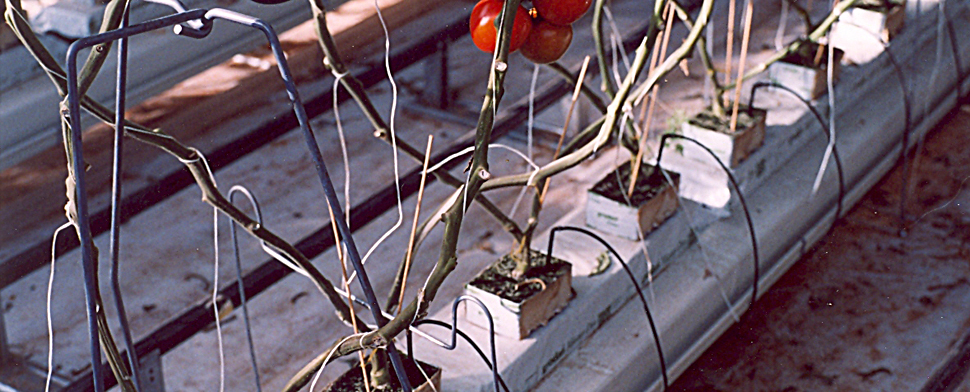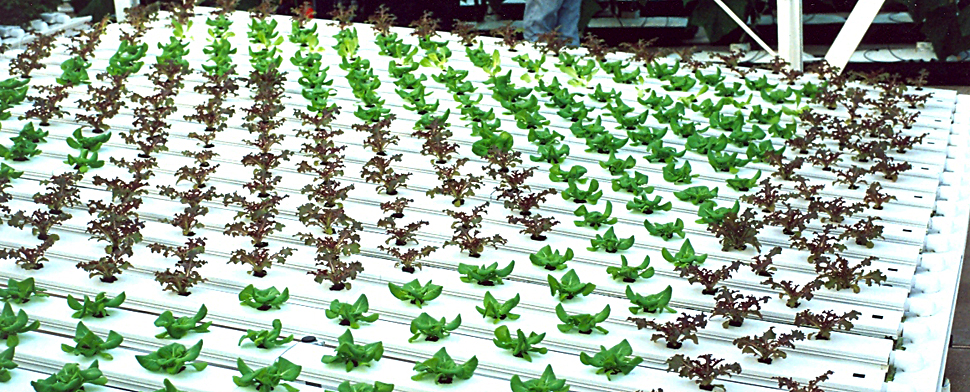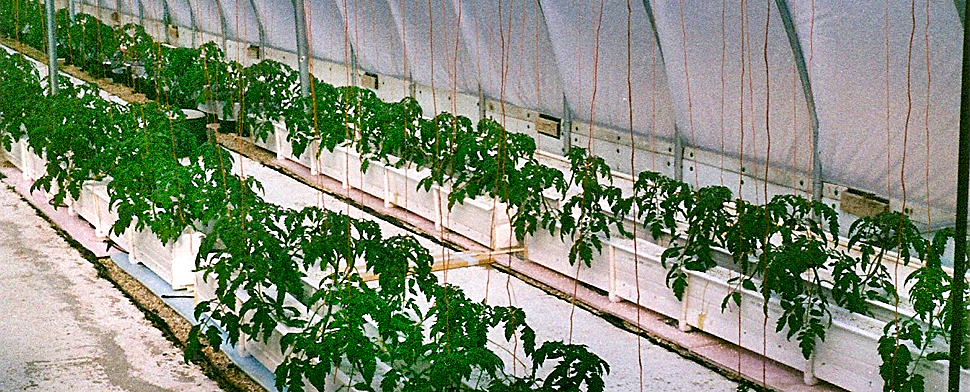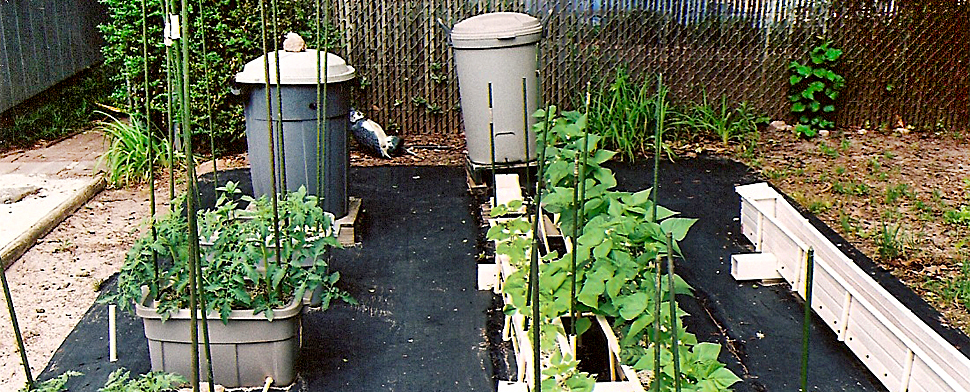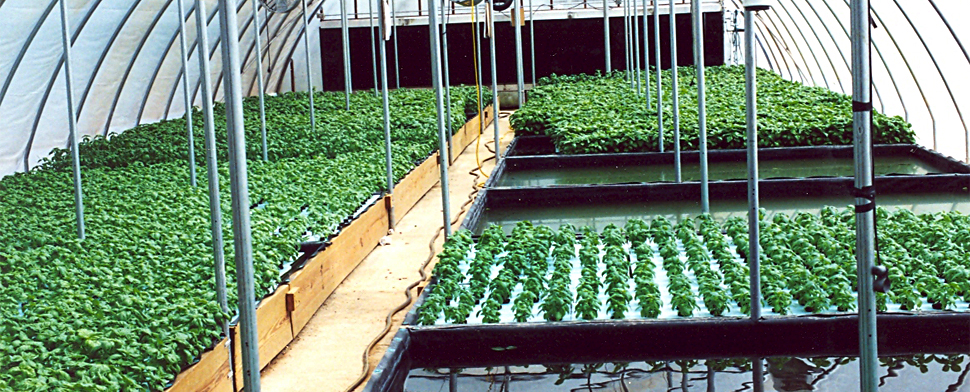Nutrient Solution Formulations
Many nutrient solutions formulations are not specified for use with a particular hydroponic method and/or plant specie. The first 3 formulations, including the Hoagland/Arnon formulations, prepare multi-element concentrates (sometimes referred to as Stock Solutions, usually given a letter designation) that are then combined to form the nutrient solution. Concentrates (Stock Solutions) lend themselves for use with injector pumps that inject a specific quantity of concentrate into a flowing stream of water to form the nutrient solution. This method of nutrient solution formulation is primarily for use with open hydroponic growing systems.
_________________________________________________________________
| Major Element Solution No. 1 (without ammonium) | ||
| Reagents | g/L to use: | mL/L |
| Potassium dihydrogen phosphate (KH2PO4) | 136 | 1.0 |
| Potassium nitrate (KNO3) | 101 | 5.0 |
| Calcium nitrate [Ca(NO3) 2.4H2O] | 236 | 5.0 |
| Magnesium sulfate (MgSO4.7H2O) | 246 | 2.0 |
| Major Element Solution No. 2 (with ammonium) | ||
| Reagents | ||
| Ammonium dihydrogen phosphate (NH4H2PO4) | 115 | 1.0 |
| Potassium nitrate (KNO3) | 101 | 5.0 |
| Calcium nitrate [Ca(NO3) 2.4H2O] | 236 | 5.0 |
| Magnesium sulfate (MgSO4.7H2O) | 246 | 2.0 |
________________________________________________________________________________________________
To prepare: weigh the designated amount of reagent into its own 1 liter (L) of water
To prepare the nutrient solution: add the aliquot (mL) designated for each reagent into 1 liter (L) of water to formulate the nutrient solution.
___________________________________________
| Micronutrient Stock Solution | g/L |
| Reagents | |
| Boric acid (H3BO3) | 2.86 |
| Manganese chloride (MnCl2.4H2O) | 1.81 |
| Zinc sulfate (ZnSO4.5H2O) | 0.22 |
| Copper sulfate (CuSO4.5H2O) | 0.08 |
| Molybdic acid (H2MoO4.H2O) | 0.02 |
____________________________________________
To prepare: weigh all the reagents into 1 liter (L) of water. Add 1 mL concentrated nitric acid (HNO3) and warm to assist in dissolving all the reagents.
Iron
For Solution No.1: 0.5% iron ammonium sulfate [FeSO4(NH4)2SO4.6H2O]; to use: 1 mL/L nutrient solution.
For Solution No.2: 0.5% iron chelate; to use: 2 mL/L nutrient solution
To prepare the nutrient solution: add 1 mL Micronutrient Stock Solution into 1 liter (L) of nutrient solution.
Additional Comments: The author when using these 2 formulations found that the P level is too high, and therefore the aliquot should be 0.5 mL/L rather than 1.0 mL/L for the P-containing reagents. For the Mg-containing reagent, increase the aliquot to 3.0 mL/L from 2 mL/L.
For the Micronutrient Stock Solution, increase the g/L of zinc sulfate (ZnSO4.5H2O) to 0.44 g/L.
To utilize the synergistic effect that ammonium (NH4) has on the root absorption of N as the nitrate (NO3–) anion, add one teaspoon of either ammonium nitrate (NH4NO3) or ammonium sulfate [(NH4) 2SO4] to the potassium nitrate (KNO3) reagent in the Major Element Solution No. 1 formulation.
Dilution for use with the sub-irrigation hydroponic method: add each of the designated mL of the Major Element Stock Solution No. 1 (without ammonium) and the Micronutrient Stock Solution into 1 gallon of water.
– – – – – – – – – – – – – – – – – – – – – – – – – – – – – – – – – – – – – – – – – – – – – – – –
In this formulation, all of the reagents are dissolved in 1,000 L of water to form a complete nutrient solution. The procedure can be cumbersome when large volumes of nutrient solution are needed.
__________________________________________________________
Theoretically Ideal General Purpose Complete
Nutrient Solution
__________________________________________________________
| Reagents | g/1,000 L |
| Calcium nitrate [Ca(NO3) 2.4H2O] | 1,003 |
| Magnesium sulfate (MgSO4.7H2O) | 513 |
| Potassium dihydrogen phosphate (KH2PO4) | 263 |
| Potassium nitrate (KNO3) | 583 |
| Boric acid (H3BO3) | 1.70 |
| Copper sulfate (CuSO4.5H2O) | 0.39 |
| Manganese sulfate (MnSO4.4H2O) | 6.10 |
| Ammonium molybdate [(NH4) 6Mo7O24.4H2O)] | 0.37 |
| Zinc sulfate (ZnSO4.7H2O) | 0.30 |
__________________________________________________________
– – – – – – – – – – – – – – – – – – – – – – – – – – – – – – – – – – – – – – – – – – – – – – – –
There are circumstances when formulating a nutrient solution that one or only several of the major elements are needed. Stock solutions containing one or 2 of the major elements: N, P, K, Ca, Mg and S, can be useful when formulating a nutrient solution when a particular elemental content/concentration is required, or for reconstituting a nutrient solution that is to be re-circulated when only one element or a group of elements are needed.
__________________________________________________________________
General Purpose Major Element Stock Solutions
__________________________________________________________________
| Major Element Stock Solutions | ||
| Reagents | g/L to use: | mL/L |
| Calcium nitrate [Ca(NO3) 2.4H2O] | 787 | 1.25 |
| Magnesium sulfate (MgSO4.7H2O) | 329 | 1.5 |
| Potassium dihydrogen phosphate (KH2PO4) | 91 | 3.0 |
| Potassium nitrate (KNO3) | 169 | 3.9 |
___________________________________________________________________________________________________
To prepare: dissolve each reagent in its own 1 L of water.
To prepare the nutrient solution: add the designated to use aliquot to 1 L of water.
– – – – – – – – – – – – – – – – – – – – – – – – – – – – – – – – – – – – – – – – – – – – – – – – – – – – – –
A micronutrient formulation for general purpose use can be useful when formulating a nutrient solution, or when reconstituting a nutrient solution that is to be re-circulated by only adding the micronutrients that have been depleted.
_________________________________________________________
General Purpose Micronutrient Stock Solution
_________________________________________________________
| Micronutrient Stock Solution | |
| Reagents | g/L |
| Boric acid (H3BO3) | 1.23 |
| Copper sulfate (CuSO4.5H2O) | 0.17 |
| Manganese sulfate (MnSO4.4H2O) | 1.50 |
| Ammonium molybdate [(NH4)6Mo7O24.4H2O)] | 0.06 |
| Zinc sulfate (ZnSO4.7H2O) | 0.38 |
_____________________________________________________________________________________
To prepare: dissolve all the reagents in 1 liter (L) of water
To use: add 1 mL of the prepared Micronutrient Stock Solution to 1 liter (L) of a major element nutrient solution, or to a nutrient solution that is to be re-circulated to restore its the micronutrient concentration.
– – – – – – – – – – – – – – – – – – – – – – – – – – – – – – – – – – – – – – – – – – – – – – – –
Specialized Nutrient Solution Formulations
Some nutrient solution formulations have general use applications that only contain the micronutrients, or they have specialized use based on the balance among the elemental constituents.
________________________________________________
Arnon’s Micronutrient Formula
_________________________________________________
| Reagents | mg/L |
| Boric acid (H3BO3) | 0.48 |
| Copper sulfate (CuSO4.5H2O) | 0.008 |
| Manganese sulfate (MnSO4.H2O) | 0.25 |
| Zinc sulfate (ZnSO4.7H2O) | 0.035 |
| Molybdic acid (MoO3.2H2O) | 0.1104 |
___________________________________________________________________________
To prepare: dissolve all reagents in 1 liter (L) of nutrient solution.
– – – – – – – – – – – – – – – – – – – – – – – – – – – – – – – – – – – – – – – – – – – – – – – –
Solid Matrix Formulation
There is significant advantage in having the reagents in solid form for making a nutrient solution so that only a weight or volume measurement is sufficient to make a nutrient solution.
| Reagent A |
| Calcium nitrate [Ca(NO3) 2.4H2O] |
| Reagent Mix B | grams | ounces |
| Potassium nitrate (KNO3) | 2,275 | 80.25 |
| Magnesium sulfate (MgSO4.7H2O) | 1,757 | 62.00 |
| Potassium dihydrogen phosphate (KH2PO4) | 878 | 31.00 |
| Boric acid (H3BO3) | 6.0 | 0.200 |
| Copper sulfate (CuSO4.5H2O) | 2.0 | 0.075 |
| Zinc sulfate (ZnSO4.7H2O) | 1.5 | 0.053 |
| Ammonium molybdate [(NH4)6Mo7O24.4H2O] | 0.35 | 0.0125 |
| Iron EDTA | 132.0 | 4.65 |
__________________________________________________________________________________________________
Preparation of Reagent Mix B: blend all the reagents together and thoroughly mix. The granular size of each reagent should be the same to ensure a homogenous mix.
To prepare the nutrient solution: to 10 liters (2.65 gallons) of water, add 1 level teaspoon of Reagent A, stir until dissolved, and then add 1 level teaspoon of Reagent Mix B and stir to dissolve.
Comment: The reagents must be of uniform particle size. To prepare a homogenous Reagent Mix B is not an easy task so that each teaspoon aliquot contains the weight proportion of each reagent. In addition, the mix must be stored in a moisture-free atmosphere to prevent water adsorption.

